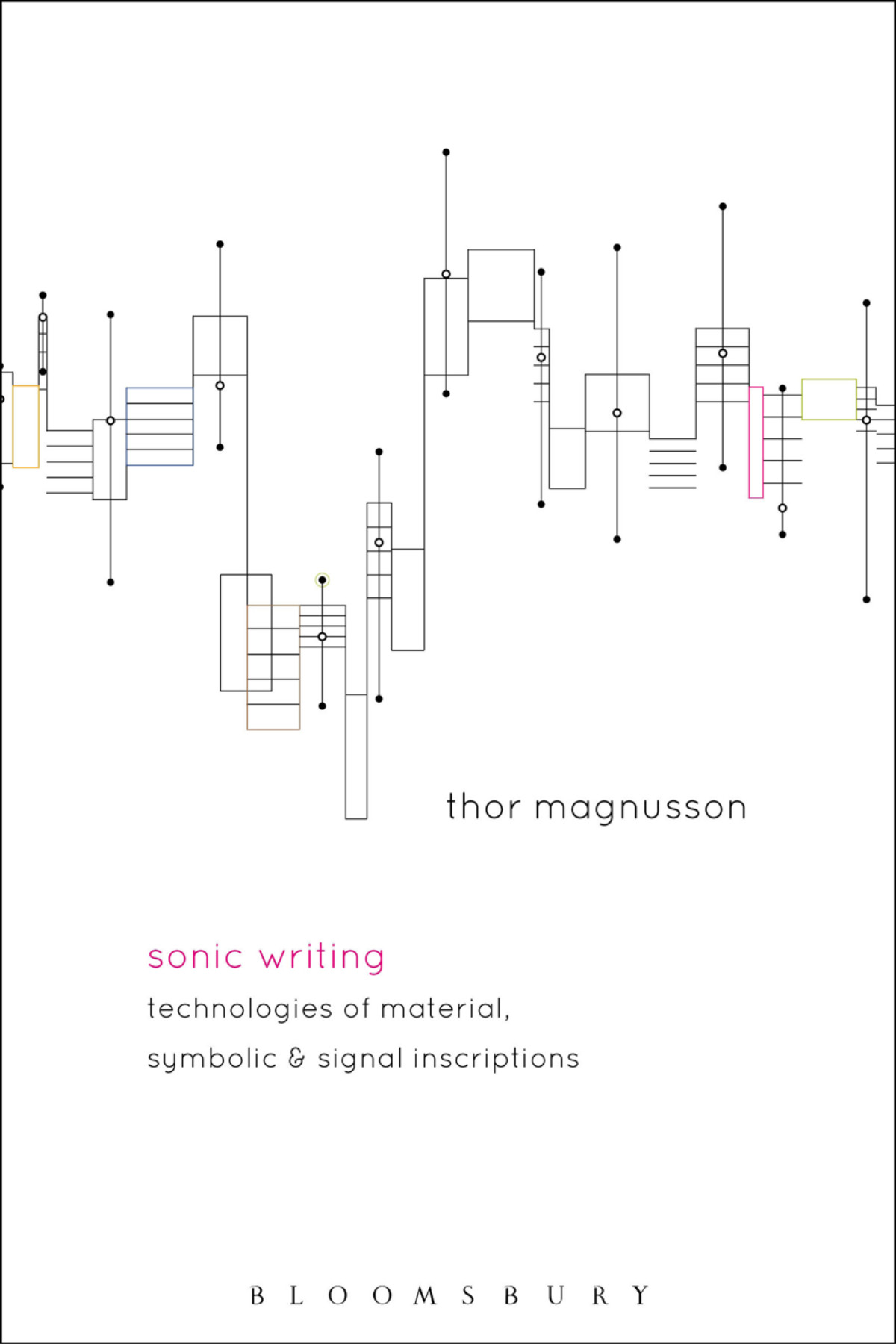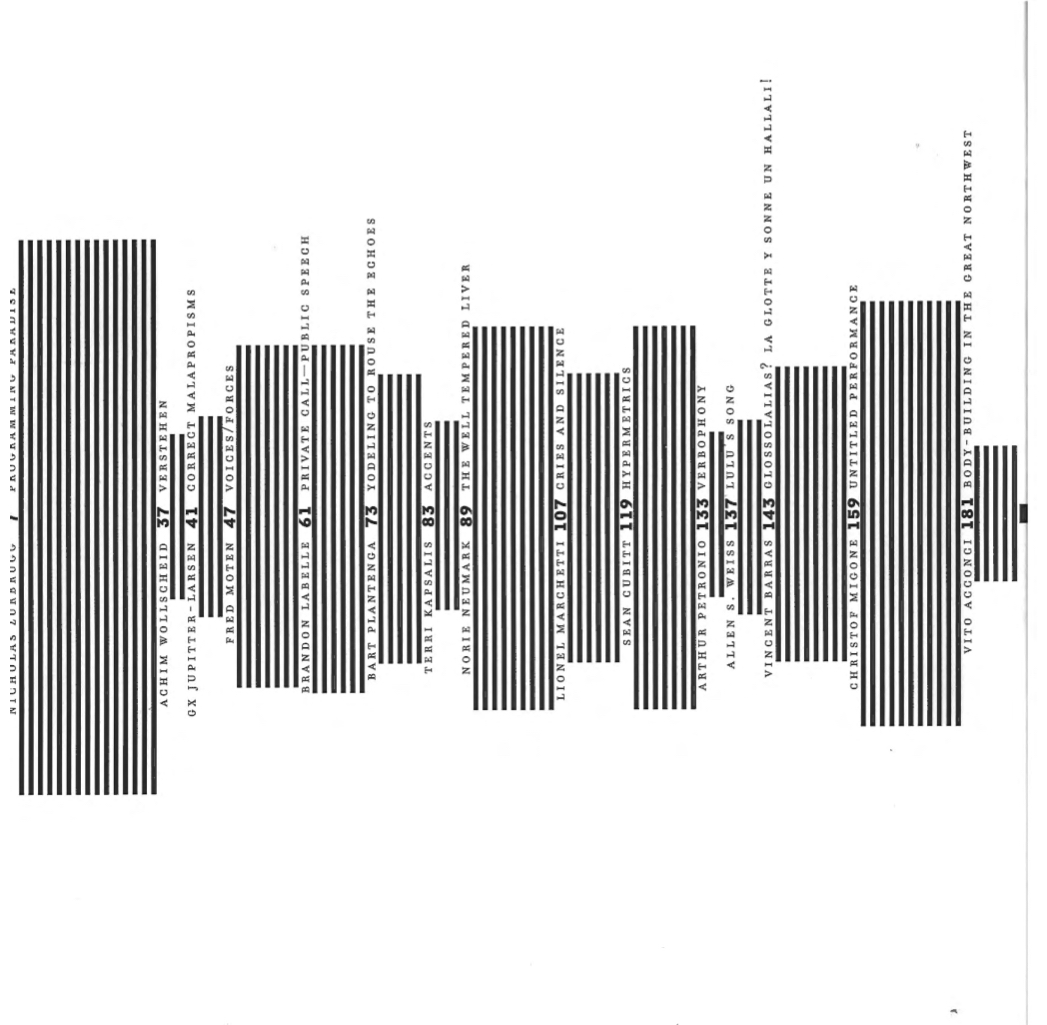Thor Magnusson: Sonic Writing: Technologies of Material, Symbolic, and Signal Inscriptions (2019)
Filed under book | Tags: · artificial intelligence, computer music, machine learning, media, media technology, media theory, music, musical instruments, notation, phonograph, sound, sound recording, writing

“Sonic Writing explores how contemporary music technologies trace their ancestry to previous forms of instruments and media. Studying the domains of instrument design, musical notation, and sound recording under the rubrics of material, symbolic, and signal inscriptions of sound, the book describes how these historical techniques of sonic writing are implemented in new digital music technologies. With a scope ranging from ancient Greek music theory, medieval notation, early modern scientific instrumentation to contemporary multimedia and artificial intelligence, it provides a theoretical grounding for further study and development of technologies of musical expression. The book draws a bespoke affinity and similarity between current musical practices and those from before the advent of notation and recording, stressing the importance of instrument design in the study of new music and projecting how new computational technologies, including machine learning, will transform our musical practices.
Sonic Writing offers a richly illustrated study of contemporary musical media, where interactivity, artificial intelligence, and networked devices disclose new possibilities for musical expression. Thor Magnusson provides a conceptual framework for the creation and analysis of this new musical work, arguing that contemporary sonic writing becomes a new form of material and symbolic design–one that is bound to be ephemeral, a system of fluid objects where technologies are continually redesigned in a fast cycle of innovation.”
Publisher Bloomsbury Academic, New York & London, 2019
ISBN 9781501313851, 1501313851
xiv+290 pages
Reviews: Gregory Taylor (Cycling ’74, 2019), Diana Chester (Interference, 2019).
Author’s research blog
Publisher
WorldCat
Brandon LaBelle, Christof Migone (eds.): Writing Aloud: The Sonics of Language (2001)
Filed under book | Tags: · avant-garde, language, music, performance art, sound, sound poetry, voice, writing

“Writing Aloud is an anthology focusing on the relationship of language to sound, writing to music, and brings together a highly diverse collection of essays, interviews, meditations, visual projects, text-sound scores and audio by some of the leading individuals in the field of cultural and performance studies, experimental music and contemporary art.
Starting from the perspective that the sound of the voice is crucial to our perceptions and understandings of language, to the creative possibility of being without language, Writing Aloud examines the repercussions of such a perspective. Considering the sonics of words, it extends this examination of vocalization and articulation into how it contributes to and influences communication and notions of self-recognition. And further, how orality effects the act of writing itself, stages the tension between sense and non-sense, and provides space for self-reflection.
Through cultural, historical, linguistic, musical and artistic histories and practices, this field of research is addressed in order to open up a diversity of attitudes and approaches toward a broader understanding of what it means to speak. Such works as Nicholas Zurbrugg’s detailed examination of the history of sound-poetry, which underscores this often under-represented field as being a vital link between the avant-gardes of modernism and contemporary culture; Sean Cubitt’s meditation on the voice in relation to contemporary technologies; and Fred Moten’s examination of the Black avant-garde through the works of Billy Strayhorn, Delaney, and Antonin Artaud in relation to deeper questions of identity – these original works advance our understanding of ‘vocalization’ as existing within a complex and highly charged social, political and cultural arena where identity is a contested site.
In conjunction with these analytical works, Writing Aloud also provides readers with some valuable reconsiderations and reproductions of historical work, such as Marina Abramovic’s performance from 1975, Freeing the Voice, in which the artist exhales every breath as a scream for one hour; plus a revealing and insightful interview with the composer Alvin Lucier, whose compositions from the 60s to today continue to challenge and astound listeners; a valuable document of a long lost French artist, Arthur Petronio, whose recordings from the mid-60s, Verbophonie, trace a highly personal and idiosyncratic terrain of voice and electronics; and important visual and audio documentation of an early installation, Body Building, by the artist Vito Acconci. Through such a range of contributions Writing Aloud suggests links between disparate practices and stimulates conversations between disciplines, one which follows the line where text and sound meet, speaking and music collide, and theory and writing converse.
Also included in the anthology are GX Jupitter-Larsen, Terri Kapsalis, Norie Neumark, Kim Dawn, Alexandre St-Onge, Jocelyn Robert, Robert Ashley, Achim Wollscheid, Bart Plantenga, Vincent Barras, Michel Chion, John Duncan, and others.”
Publisher Errant Bodies, Los Angeles, 2001
ISBN 9780965557030, 0965557030
279 pages
via cmigone
Reviews: Christopher DeLaurenti (The Tentacle, 2001), Jim Drobnick (Parachute, 2002), John Dack (Computer Music Journal, 2003).
PDF (37 MB)
Comment (0)Matthew G. Kirschenbaum: Track Changes: A Literary History of Word Processing (2016)
Filed under book | Tags: · computation, digital humanities, history of literature, history of technology, literary theory, materiality, media archeology, media theory, technology, word processing, writing

“The story of writing in the digital age is every bit as messy as the ink-stained rags that littered the floor of Gutenberg’s print shop or the hot molten lead of the Linotype machine. During the period of the pivotal growth and widespread adoption of word processing as a writing technology, some authors embraced it as a marvel while others decried it as the death of literature. The product of years of archival research and numerous interviews conducted by the author, Track Changes is the first literary history of word processing.
Matthew Kirschenbaum examines how the interests and ideals of creative authorship came to coexist with the computer revolution. Who were the first adopters? What kind of anxieties did they share? Was word processing perceived as just a better typewriter or something more? How did it change our understanding of writing?
Track Changes balances the stories of individual writers with a consideration of how the seemingly ineffable act of writing is always grounded in particular instruments and media, from quills to keyboards. Along the way, we discover the candidates for the first novel written on a word processor, explore the surprisingly varied reasons why writers of both popular and serious literature adopted the technology, trace the spread of new metaphors and ideas from word processing in fiction and poetry, and consider the fate of literary scholarship and memory in an era when the final remnants of authorship may consist of folders on a hard drive or documents in the cloud.”
Publisher Belknap Press of Harvard University Press, 2016
ISBN 9780674417076, 0674417070
xvi+344+[16] pages
via slowrotation
Reviews: Brian Dillon (The Guardian, 2016), Jessica Pressman (ALH Online Reviews, 2016), Eric Banks (Bookforum, 2016), Dylan Hicks (LA Review of Books, 2016), Kirkus Reviews (2016), Francis Russell (Hong Kong Review of Books, 2016), A. Bowdoin Van Riper (PopMatters, 2016), Leann Davis Alspaugh (Hedgehog Review, 2016), Thomas Padilla (American Archivist, 2017), Lai-Tze Fan (Papers of The Bibliographical Society of Canada, 2017), Seth Erickson (Interactions, 2017), David Walden (TUGboat, 2017), Grant Wythoff (Revista Hispánica Moderna, 2018), Elena Spadini (Umanistica Digitale, 2018).
Online companion
Publisher
WorldCat

